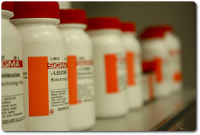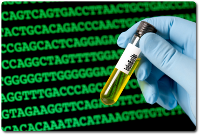Facilities
Young Laboratory

The Young lab can be found on the 6th floor of the Engineering and Science Building on the campus of Vanderbilt University. Our laboratory space includes a dedicated analytical laboratory that contains our instrumentation, a mammalian tissue culture room, a cyanobacteria culture room, and a main bench commonspace. Our laboratory shares a floor CORE support space, which includes a cold room (4°C), an autoclave, a glassware washer, and a pellet ice machine. Down the hall, facing the VandyBoy’s baseball stadium, you can find Dr. Jamey Young’s office at 624 and Lab Manager Sara Weidenbach’s office at 626. Graduate student offices are found across the hall from the laboratory facing the West End Tower.
Major Equipment
| Equipment | Usage |
| Agilent GCMS/MS 5977B/7890A | Gas Chromatography Mass Spectrometry analyzes small molecules quantitative and qualitatively. The instrument separates analytes of interest by boiling point and polarity, then analyzes mass-to-charge ratio (m/z). Analytes can be identified based on their unique fragmentation pattern, known as a mass spectrum. Samples must undergo derivatization to convert analytes to a volatilized form.
Our lab mainly analyzes polar metabolites via TBDMS derivatization and non-polar fatty acids via FAME analysis. |
| Agilent GCMS/MS 5977B/7890B | |
| YSI 2900 Bioanalyzer | The YSI utilizes membrane-bound enzymes and electrodes to quickly measure a selected few analytes. Samples undergoing this analysis require little to no preparation, and readings take less than a minute. Our bioanalyzer is configured to detect glucose, lactate, glutamine and glutamate, though other membranes can be configured to detect ammonium, choline, ethanol, glycerol, lactose, methanol, potassium, sucrose and xylose. |
| Licor Odyssey Imaging System | Our imaging system supports near infrared (NIR) and enhances chemiluminescent (ECL) western blots. Abilities include detecting multiple targets on the same blot with two channel fluorescence. The LICOR is also able to document DNA gels. |
| Cytation Imaging reader | The Cytation is a multi-mode microplate reader. Detection modes include UV-Vis absorbance, fluorescence and luminescence. This instrument is also capable of imaging culture plates. |
| Agilent HPLC 1200 with MWD and FLD detectors, and an automated fraction collector | An HPLC separates and detects analytes of interest, based on it’s affinity to the stationary phase. Our lab currently uses the HPLC to detect antibodies or amino acids, based on what stationary column is installed. We have an adenosine nucleotide quantification method in development. |
| ViCELL BLU Cell Viability analyzer | Reports cell count, viability, and diameter |
| Spectrophotometer | Quantitative measurement based on absorbance. Primarily used for optical density in our lab |
Computational Resources
In addition to personal computers assigned to all lab personnel, the Young lab maintains a 20-node Linux cluster for high-performance research computations. The NIST05 mass spectral database as well as in-house packages for metabolic flux analysis and GC-MS data processing are key software resources.
Institutional Resources

The Young lab has access to the Vanderbilt Mass Spectrometry Research Center, which offers an array of GC-MS and LC-MS instruments that are made available to researchers on a fee-for-service basis. Several other research core facilities are available throughout the Vanderbilt University Medical Center for performing various genetic, biochemical and imaging analyses. Prof. Young is a member of the Vanderbilt Diabetes Research and Training Center, which involves approximately 100 participating faculty and numerous shared resources. Most notably, the Mouse Metabolic Phenotyping Center is one of only 7 such centers that have been established by the NIH as a resource to scientists who use mice to study diabetes, obesity, diabetic complications and other metabolic diseases.